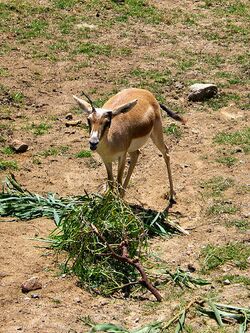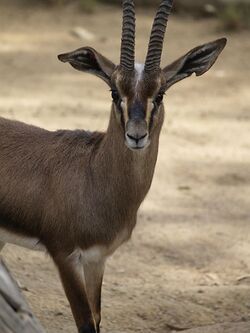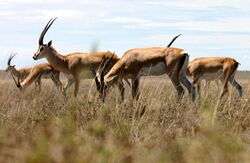Gazelle
Have you ever found yourself flipping through the TV channels, blindly hunting for something remotely stimulating to watch in the seething morass of vacuity? If so, it is entirely possible you may have paused on a nature show in desperation, hoping for some no-holds-barred bloody violence that you can pass off as "educational". If this is indeed the case, you will understand how gratifying it is when the camera cuts to a gazelle.
Now, it is true that Gazelles are not known for their aggressive nature. It is also true that they do not, in and of themselves, make for particularly exciting television: run, bound, gambol playfully, eat plants, drink water, occasionally get it on with other Gazelles - nothing much thrilling there (unless you're into animal erotica). However, this is beside the point - when you see a gazelle on TV, you can be sure the show isn't about the gazelle - it is, in fact, about something that's going to disembowel the gazelle, brutally and graphically (which should pass the time until that House marathon comes on). Scientific study has determined that this may well be the entire purpose of the Gazelle's existence, as they have been unable to establish any other.
Gazelles On Film
Gazelles are God's gift to nature documentary film crews. Why bother spending ages tracking cunning, stealthy Lions, Cheetahs or other vicious African predators when you can just latch on to a bunch of Gazelles and wait? When it sees the TV crew, any half-aware species should get at least somewhat suspicious, and perhaps prepare to make a sharp exit. But gazelles have yet to evolve this basic survival trait, so instead they just sit there, waiting to become thirty seconds of footage in the next Discovery Channel space-filler.
Gazelle deaths make good TV for several reasons - first, and most important, they are regular and plentiful, meaning viewers won't be waiting hours for the next one. Secondly, they are quite good to watch - the natural grace of the gazelle contrasts nicely with the savagery of the ensuing attack, lending quite an artistic quality to what is essentially animal snuff-movie footage. Then there are the large, cute eyes, perfect for that close-up "oh, the humanity" shot that grabs the kids' attention while the lion tears greedily into the stomach cavity. Finally, large numbers of gazelles never put predators off, meaning the camera can focus on a large group to increase the chances of recording some mutilation in short order.
This is aided in part by the lack of community instinct among gazelles - somewhat strangely for an animal that gathers in large herds. When a group of gazelles spark into flight from a predator, the one left labouring in the back is the one that's ruthlessly left to be picked off - Gazelles never help each other out. Despite the fact that sheer weight of numbers should enable them to trample over several lions if they ever got their act together, they just abandon the stragglers to get picked off in gratifyingly detailed slow-mo while the narrator raves about "efficient killing machines" and suchlike. It's almost like torture porn - the family-friendly version.
Gazelle Lifestyles
The gazelle seems to do everything in its power to maintain this status quo as well. Its diet is rich in plants with the essential minerals the carnivores need, making them highly nutritious. They spend a lot of time jumping and springing about the place unnecessarily, working off tasteless flab, keeping their meat lean and tender. They even run really slowly when they first spot a predator, jumping high into the air a few times before starting to run, which can only be to give the ravenous hunters a better chance of catching them. They have a top speed of about 50 miles an hour, but they still do this. It's called "stotting" - look it up on Wikipedia. "Stotting" is derived from the Latin word for "bringing death on yourself by being colossally stupid".
They are also meek and passive to the point of lunacy. Gazelle enclosures in the zoo are always really large, not to give the Gazelles space to run around in, but so they don't have to be too close to the other enclosures and get intimidated by other species. Gazelles can't be put too close to anything, because they are so nervous that other species can't help but get a superiority complex from being in close proximity to them. Put them next to the rabbit enclosure, for instance, and the rabbit soon develops an attitude and starts trying to stare down the foxes across the way; Church mice have been known to bully medium-sized children after spending time close to the gazelles. Anything gets an attitude when exposed to gazelles for long enough.
Long Term Survival Prospects
Looking at the facts, you'd be forgiven for thinking that, as a species, the long-term survival prospects for the gazelle are bleak. Given the choice, you may even prefer to be in a red shirt on the Starship Enterprise than be a gazelle, and those of a Hindu persuasion might pick "anything but a gazelle" for their next reincarnation. But that doesn't take all the facts into consideration.
As we've found out, an individual gazelle in the lens of a documentary film crew does have a shorter life expectancy than a pig with a sniffle. And yet, consider the other classic documentary shot of gazelles: the wide-angle aerial shot of hordes of gazelles sweeping across a plain to a water-hole - there are always vast numbers of gazelles! This leads many experts to conclude that either the gazelle survival tactic is just to breed in a fashion that makes rabbits look conservative, or that TV nature documentary film makers breed particularly dumb gazelles in secret, then release them into the wild near where they know there are some hungry predators, then just sit back. This second theory would also explain why other gazelles take no notice of the dismembering of the unfortunate interloper, who, to them, is just a total stranger stupid enough to get caught.
So on balance, the long term future of the gazelle as a species seems to be fairly secure for the time being. Which is good news for hungry cheetahs or lions, TV nature documentary cameramen, and other species looking for a quick boost to their self esteem, but possibly bad news for some gazelles - particularly the ones most proficient at "stotting".
| Featured version: 15 May 2009 | |
| This article has been featured on the main page. — You can vote for or nominate your favourite articles at Uncyclopedia:VFH. | |




